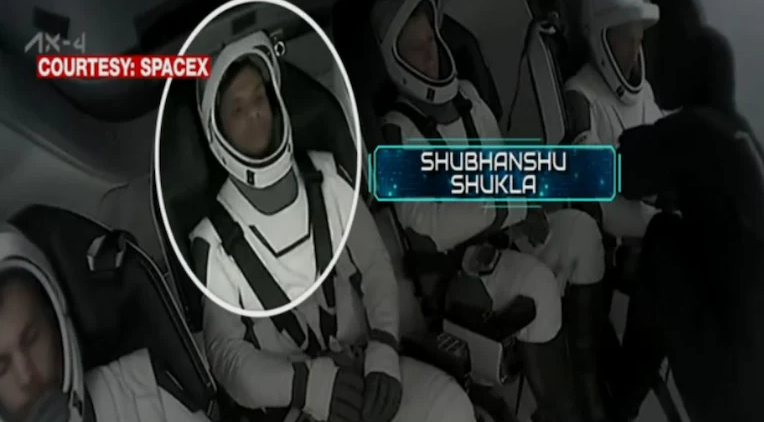6 Quick Facts on Shubhanshu Shukla’s ‘Orbiting the Earth, Jai Hind Jai Bharat’ Space Clip
The Liftoff, The Message, and The Making of a Historic Moment
A Nation’s Dream Rekindled
On the afternoon of June 25, 2025, India witnessed a moment that will be etched forever in the annals of its space history. At exactly 12:01 pm IST, a SpaceX Falcon 9 rocket roared to life from Launch Complex 39A at NASA’s Kennedy Space Center in Florida, piercing the morning skies with a payload that carried not just astronauts, but dreams and aspirations spanning generations. Aboard the Dragon Crew Capsule, part of the Axiom-4 mission, sat Group Captain Shubhanshu Shukla, the first Indian astronaut to fly into space since Rakesh Sharma’s legendary mission in 1984.
The launch marked a monumental return to human spaceflight for India – a 41-year hiatus broken with a vibrant proclamation from Earth’s orbit:
“We are orbiting the Earth. This is the start of India’s human space program. Jai Hind, Jai Bharat.”
These were Shukla’s first words, spoken moments after orbital insertion, relayed via the onboard communication systems of the SpaceX Dragon spacecraft following its separation from the Falcon 9 upper stage.
His words were more than a personal expression of pride. They were a signal flare across the cosmos, announcing India’s determined re-entry into the exclusive community of spacefaring nations with ambitions that now go beyond mere participation — toward leadership, innovation, and global partnership in the next era of human exploration.
The Crew: Four Nations, One Mission
The Axiom-4 mission, operated by Houston-based Axiom Space, brought together an international crew of four astronauts:
- Group Captain Shubhanshu Shukla – Representing India and the Indian Air Force.
- Dr. Peggy Whitson – Veteran NASA astronaut from the United States, serving as the mission commander.
- Slawosz Uznanski-Wisniewski – Polish astronaut and engineer from ESA.
- Tibor Kapu – Flight specialist from Hungary and a key proponent of European commercial space research.
This was the fourth private astronaut mission to the International Space Station (ISS) under NASA’s Commercial Crew Program and marked the first-ever mission carrying an Indian astronaut under a commercial spaceflight program. Unlike the governmental collaborations of the Cold War-era spaceflights, Axiom-4 reflected the rise of private-public partnerships, cross-border innovation, and new-age commercial diplomacy in low-Earth orbit.
Countdown to Glory: The Pre-launch Tensions
Leading up to the launch, there were multiple delays and critical final-stage technical troubleshooting, typical of high-stakes spaceflight. One particularly tense moment came just minutes before the terminal phase of the countdown. Engineers worked against the clock to resolve a data transmission failure related to the real-time wind information necessary for the spacecraft’s Launch Escape System (LES) — a crucial safety mechanism that ensures the crew’s survival in case of an in-flight anomaly.
At T-minus 36 minutes, the situation remained unresolved. But precisely at T-minus 35 minutes, the upload of wind data was confirmed successful, allowing the countdown to cross the critical “go/no-go” threshold. What followed was a meticulously executed sequence of operations culminating in the successful liftoff at the designated window — a testament to human ingenuity, coordination, and resilience under pressure.
The Launch: Reaching for the Stars
At 12:01 pm IST (2:31 am EDT), the Falcon 9 lifted off under clear skies, producing a trail of fire and thunder across the Atlantic coastline. The first-stage booster — a proven workhorse of the Falcon fleet — performed nominally, delivering a clean trajectory and separating after roughly 2 minutes and 38 seconds. It then executed a precise re-entry burn, landing on the autonomous drone ship “Of Course I Still Love You” stationed in the Atlantic Ocean.
The Dragon capsule — codenamed “Endeavour” for this flight — successfully separated from the second stage and initiated its orbital maneuvering burn to stabilize at an altitude of approximately 400 kilometers, matching the altitude of the ISS. It was in these moments, as the spacecraft reached stable orbit, that Group Captain Shukla’s voice echoed from space — firm, clear, and deeply moving for a nation long awaiting its second tryst with human spaceflight.
The Message: Words that Moved a Nation
With the Tiranga (Indian tricolour) proudly emblazoned on his mission suit, Group Captain Shukla addressed the people of India from Earth’s orbit:
“Namaskar, my dear countrymen! What a ride! We are back in the space once again after 41 years. It’s an amazing ride. We are revolving around the Earth at a speed of 7.5 kilometres per second. The Tiranga embossed on my shoulders tells me that I am with all of you. This journey of mine is not a beginning to the International Space Station (ISS) but to India’s Human Space Programme. I want all of you to be part of this journey. Your chest, too, should swell with pride…Together, let’s initiate India’s Human Space Programme. Jai Hind! Jai Bharat!”
His words weren’t scripted by bureaucrats or publicists. They came from the heart — the heart of an aviator, a patriot, and now a spacefarer representing 1.4 billion Indians. For the children in rural schools, for young engineers in ISRO labs, for dreamers across every town and village — this was a signal that the future of Indian space exploration had arrived.
Significance: More Than a Symbolic Return
While Shukla’s journey to the ISS is part of a commercial mission, its symbolic and strategic implications for India are vast:
- It marks India’s entry into the era of commercial astronautics, validating its capabilities for future international partnerships.
- It sets the stage for the Gaganyaan mission, ISRO’s indigenous human spaceflight project aiming to send Indian astronauts aboard a Made-in-India spacecraft by 2026.
- It positions India within the global market of space diplomacy and low-Earth orbit research, aligned with the goals of entities like NASA, ESA, and private ventures like Axiom and SpaceX.
India’s space sector has undergone accelerated liberalization in recent years, with increasing private participation, defense collaboration, and global tie-ups. Shukla’s flight acts as both an inspiration and a proof-of-concept, establishing Indian astronautical talent in the private orbital economy.
Global Reactions and National Celebrations
As news of the launch spread, celebrations broke out across India. ISRO scientists at Sriharikota applauded. School children in Gujarat and Tamil Nadu waved flags. Prime Minister Narendra Modi tweeted his congratulations, calling the moment “a proud leap forward for Bharat.” Messages from global space agencies, including ESA and JAXA, poured in acknowledging India’s re-emergence as a human spaceflight participant.
Meanwhile, media outlets across the world highlighted the historic resonance of this launch. Comparisons were drawn between Rakesh Sharma’s iconic “Sare Jahan Se Accha” message in 1984 and Shukla’s call to unite the nation around its space ambitions in 2025.
What Lies Ahead: Journey to the ISS
As of this writing, the Axiom-4 spacecraft is en route to the International Space Station, with docking expected after 17 hours of orbital maneuvers and systems checks. During their time aboard the ISS, the crew will carry out 22 microgravity experiments, educational outreach events, and international scientific collaborations, including payloads involving India’s private space startups and defense technologies.
Group Captain Shukla is also scheduled to conduct two live sessions with Indian students and young scientists, broadcast via ISRO’s platforms and national television.
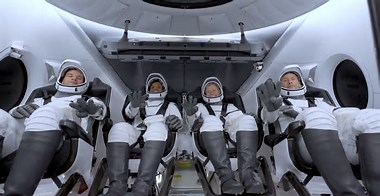
Orbital Chase: Dragon’s Approach to the ISS
Following the flawless separation of the Crew Dragon spacecraft from the Falcon 9 upper stage, Axiom-4 entered a precise orbital trajectory, gradually aligning itself with the International Space Station (ISS). Traveling at approximately 28,000 km/h (7.5 km/s), the capsule performed a series of phased burns and trajectory corrections, synchronizing altitude and velocity with the station.
The journey from launch to docking lasted nearly 17 hours, with the capsule transitioning through various checkpoints:
- Initial orbit insertion and systems check
- Height adjustment maneuvers
- Proximity operations initiation
- Final approach at 200 meters
- Soft capture and hard docking
NASA confirmed the successful docking of Axiom-4 at Harmony module’s forward port at precisely 5:17 am EDT (2:47 pm IST) on June 26, 2025. The docking utilized SpaceX’s automated rendezvous navigation system, but astronauts remained ready to assume manual control in case of any anomalies — a protocol standard since the Crew Dragon’s first flights.
As the spacecraft latched onto the ISS and created an airtight seal, ground teams at NASA’s Johnson Space Center, Axiom Mission Control, and ISRO’s Mission Operations Complex (MOX) in Bengaluru jointly monitored cabin pressurization and integration procedures.
Hatches Open, India Enters the ISS
The symbolic moment arrived when Group Captain Shukla floated through the ISS hatch, marking his official entry into the orbital laboratory — a pressurized marvel of international engineering orbiting 400 km above Earth. Awaiting them were seven long-duration ISS crew members, including cosmonauts from Roscosmos, astronauts from NASA and JAXA, and one ESA scientist.
Shukla’s first action aboard the station was to offer a salute in zero gravity and unfurl a small Indian flag, previously flown aboard Rakesh Sharma’s Soyuz mission and preserved at the National Museum in Delhi. It had been symbolically included in Shukla’s personal kit, bridging India’s past and future in human spaceflight.
His voice, transmitted live to Indian classrooms and space science centers, delivered a new message:
“The dream that began with Wing Commander Sharma has now reached orbit again. But this is only the beginning. India belongs here — in space, in science, in the stars. Let us aim even higher.”
The Mission Timeline: 14 Days in Orbit
The Axiom-4 mission is scheduled to spend 14 days aboard the ISS, during which the crew will execute an ambitious set of scientific, educational, and diplomatic activities, representing the most diverse commercial human research program ever attempted by an Indian astronaut.
Shukla’s role as Mission Specialist-2 includes responsibilities such as:
- Operating low-gravity payload experiments focused on metallurgy, biotechnology, and radiation shielding
- Participating in AI-driven robotic arm control tests in coordination with Japanese and European engineers
- Hosting educational live calls with students in Indian schools and engineering institutions
- Collaborating with astronauts from Poland and Hungary on multi-national science outreach modules
He will also assist in hypoxia and cardiovascular resilience studies, offering valuable data to Indian medical researchers at AIIMS and DRDO-affiliated labs working on Gaganyaan crew endurance protocols.
The Indian Payload: Science from and for Bharat
Aboard the Dragon capsule were also five Indian-designed scientific payloads, part of a collaboration between ISRO, IN-SPACe, and startups in India’s burgeoning space ecosystem. These include:
- BIO-NAV (Biological Navigation Module)
Developed by students at IIT Bombay, this study explores neural orientation changes in microgravity using fruit flies as model organisms. - VAYU-AQUA (Atmospheric Water Harvesting Testbed)
A module developed by a Bengaluru-based startup focused on sustainable water condensation technologies for lunar habitats. - SAMPARK-1 (Quantum Communication Pilot Node)
Created by a DRDO-backed research cell in Hyderabad to test quantum key distribution in space, part of India’s cybersecurity roadmap. - GAGRAVITY (Gravity-Independent Agriculture Toolkit)
A Pune-based agritech initiative exploring soil-less germination of native Indian crops like amaranth and mustard in space. - VELOCITRON (Mini Particle Accelerator Diagnostics Unit)
An experimental compact diagnostics sensor suite for studying solar particle events and radiation shielding effectiveness, designed by BITS Pilani.
Each experiment has been strategically timed and pre-programmed with inputs from ground control teams in India and will return home with valuable data sets, potentially opening new commercial and scientific frontiers.
India’s Astronautical Training Ecosystem
Group Captain Shukla’s flight is also a window into India’s revamped astronaut training pipeline. While initial selection and training were facilitated by ISRO and the Indian Air Force, Shukla also underwent advanced modules in:
- NASA’s Johnson Space Center: For EVA simulations, Dragon system integration, and medical preparedness
- Gagarin Cosmonaut Training Centre (Russia): For survival training, water egress, and cross-agency interoperability
- Axiom’s Houston facilities: For commercial protocols, customer payload operations, and multi-cultural mission integration
India now maintains a dedicated Human Spaceflight Training Centre (HSTC) in Challakere, Karnataka, under ISRO’s Human Spaceflight Programme directorate. The facility hosts analog simulation missions, hyperbaric chambers, and microgravity familiarization labs, forming the backbone of India’s Gaganyaan astronaut corps.
The Diplomatic and Strategic Impact
Beyond the science, Axiom-4’s success — and India’s participation — signals a broader strategic recalibration:
- Space Diplomacy: India is positioning itself as a reliable partner in the global low-Earth orbit (LEO) economy. Shukla’s presence helps expand bilateral engagements with the US, EU, and emerging space nations.
- Commercial Viability: Indian space startups — backed by IN-SPACe and venture capital — now see human spaceflight as a feasible horizon, not just a distant dream.
- Soft Power Projection: The launch enhances India’s global image, inspiring millions and sending a message that India is ready for leadership in the upcoming decade of lunar and Martian exploration.
- Defense Signaling: With adversaries like China and rising actors like Iran expanding their military space agendas, Shukla’s flight also showcases India’s growing aerospace dual-use capabilities.
Voices from Earth: National Reactions and International Applause
India responded with a chorus of pride and emotion. Across schools, college campuses, military academies, and social media, people celebrated Shukla as a national icon. Hashtags like #JaiHindFromSpace and #IndiaInOrbit trended globally.
The Prime Minister’s address praised the astronaut and the private-public synergy that made the flight possible:
“Today, Group Captain Shukla has become a symbol of our Viksit Bharat. His voice from orbit will echo in the dreams of every young Indian. This is not just a mission; this is a movement.”
International praise also followed. NASA Administrator Bill Nelson hailed India’s return to space as “a powerful example of global cooperation.” ESA called Shukla’s entry into the ISS “a promising beginning to shared leadership in orbit.”
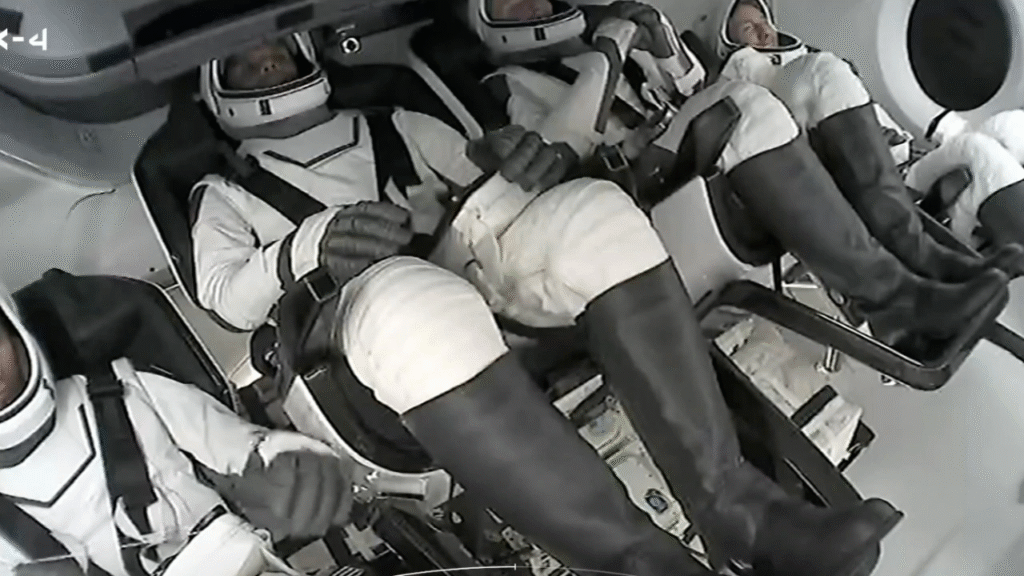
Gaganyaan: India’s Own Human Space Mission Enters Final Countdown
While the Axiom-4 mission has been a breakthrough in global collaboration, it is also a stepping stone toward something even more significant — India’s indigenous human spaceflight programme, Gaganyaan.
Conceived officially in 2018 and spearheaded by the Indian Space Research Organisation (ISRO), the Gaganyaan mission aims to send three Indian astronauts into low-Earth orbit aboard an entirely Indian-built spacecraft and launch system.
India’s long wait for its next astronaut after Rakesh Sharma (1984) was initially expected to end by 2022, but delays due to the COVID-19 pandemic, technical upgrades, and geopolitical concerns pushed timelines. Now, with Shukla’s Axiom-4 mission acting as a real-time rehearsal of astronaut operations, Gaganyaan is poised for launch by mid-2026.
Key objectives of the Gaganyaan programme:
- Demonstrate crew safety systems through autonomous abort mechanisms and real-time trajectory correction.
- Validate India’s Crew Module and Environmental Control and Life Support System (ECLSS).
- Establish reusability and precision splashdown operations in the Bay of Bengal.
- Build a national astronaut corps trained in India and exposed to global standards through collaborations like Axiom-4.
The crew for Gaganyaan has been selected — four test pilots from the Indian Air Force (IAF) — and are undergoing advanced training at the Human Space Flight Centre (HSFC) in Bengaluru and Gagarin Cosmonaut Training Centre in Russia.
Dragon vs Gaganyaan: A Tale of Two Spacecrafts
As Group Captain Shukla flies aboard the Crew Dragon “Endeavour”, India is closely observing the design architecture, software reliability, and operational autonomy of the SpaceX capsule — insights that will significantly inform the finishing stages of India’s Gaganyaan spacecraft.
A technical comparison:
| Feature | SpaceX Crew Dragon | ISRO Gaganyaan Crew Module |
|---|---|---|
| Launch Vehicle | Falcon 9 | GSLV Mk III (renamed LVM-3) |
| Crew Capacity | Up to 7 | 3 |
| Life Support | Advanced ECLSS with redundancy | Indigenous ECLSS under final testing |
| Autonomy | Full autonomous + manual override | Semi-autonomous with planned manual fallback |
| Reusability | Yes (multiple flights per capsule) | Initially expendable; reusable version in roadmap |
| Launch Escape System | Integrated SuperDraco thrusters | Crew Escape System with rocket tower (tested 2020) |
| International Docking System | NASA-certified for ISS | Compatible with international ports planned for future use |
| Splashdown Recovery | Atlantic Ocean (SpaceX ships) | Bay of Bengal (Indian Navy, Coast Guard coordinated) |
India’s strategy is deliberately cautious but foundationally ambitious. While SpaceX benefits from over two decades of R&D, ISRO’s approach is cost-effective, modular, and sustainable, with an eye on long-term lunar and interplanetary goals.
Human Spaceflight Infrastructure: India’s Expanding Capabilities
In parallel to astronaut training and capsule development, India has significantly expanded its space infrastructure, with new facilities catering specifically to human-rated missions:
- Human Space Flight Centre (HSFC) – Bengaluru
- Headquarters of the Gaganyaan program
- Crew health monitoring, simulators, mission planning
- Launch Complex Upgrades at Sriharikota (SHAR)
- LVM-3 modifications for crew escape systems
- Emergency response platforms installed near launch towers
- Space Recovery Facility – Bay of Bengal
- Indian Navy commissioned special operations vessels
- Thermal sensors, sonar pingers, and rapid deployment crafts tested
- ISRO Inertial Systems Unit (IISU) – Thiruvananthapuram
- Mission-critical inertial navigation systems for Gaganyaan capsule
- Human-rated avionics developed in tandem with HAL and BEL
- IN-SPACe and NSIL Hubs – Gujarat & Bengaluru
- Provide private startups access to human flight support systems
- Collaborative R&D and payload integration for space medicine, AI, and manufacturing
India’s Growing Astronaut Corps and Future Missions
With Group Captain Shukla breaking new ground aboard Axiom-4, India’s future astronaut corps is rapidly diversifying. ISRO has shortlisted a second batch of 10 astronaut candidates, including 2 women, in partnership with the IAF and Navy. By 2027, India is expected to have a rotating pool of 15 flight-ready astronauts capable of:
- Conducting space station missions
- Supporting long-duration lunar orbit tests
- Flying as payload specialists aboard allied platforms (NASA, ESA, JAXA)
Additionally, the “Vyommitra” humanoid robot, an autonomous robotic astronaut, is expected to fly on a test Gaganyaan mission in 2025, simulating human parameters in a high-stress, near-space environment.
India is also working on post-Gaganyaan ambitions, which include:
- Bharatiya Space Station by 2035 (announced in 2023)
- Indian Lunar Astronaut mission in partnership with JAXA (under discussion)
- Indian participation in the Artemis Accords (currently under review)
Global Cooperation and India’s Strategic Position in Orbit
Group Captain Shukla’s mission symbolizes India’s post-2020 shift from isolationist space policy to inclusive strategic collaboration. Key developments include:
- Bilateral Agreements with NASA, ESA, Roscosmos, and JAXA for data sharing, training, and mission synergy
- India’s potential inclusion in the Artemis Accords, which would formalize its role in future lunar gateway missions
- Participation in the Lunar Polar Exploration Mission (LUPEX) with JAXA in 2026
- Private Sector Synergy with Axiom, Blue Origin, and Sierra Space through NSIL and IN-SPACe
- Engagement with emerging spacefaring nations like Vietnam, Brazil, Egypt, and South Africa through ISRO’s GROWTH initiative
India’s Gaganyaan and beyond will not just be a technological leap — it is poised to become a geostrategic, educational, and industrial multiplier across South Asia, the Middle East, and the Global South.
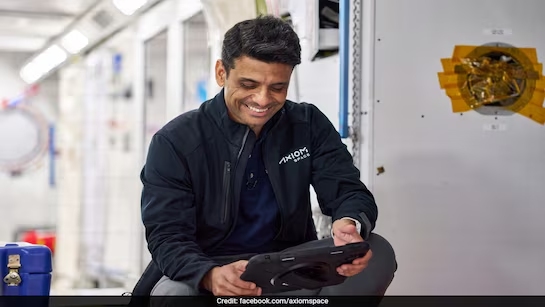
The Role of Public Sentiment and Scientific Inspiration
The success of Shukla’s mission and the public’s overwhelming emotional response signal a key shift: space science is becoming mainstream in India. From viral YouTube explainer videos in Hindi and Tamil to ISRO-themed school fairs, and even astronaut-themed mobile games, there’s a growing grassroots push toward space literacy.
India’s New Education Policy (NEP) now includes modules on astronomy, astrophysics, and aerospace engineering, ensuring the next generation sees space not as science fiction but as a career path and national mission.
The government has also launched “Aditya-SETU”, a public science outreach programme that will connect students with space scientists, astronauts, and engineers in over 1,000 schools by 2027.
Contributions Aboard the ISS: Shukla’s Operational Rol
Once docked aboard the International Space Station (ISS), Group Captain Shubhanshu Shukla transitioned from a national symbol to a functioning crew member of a multinational orbital lab. His role was not ceremonial; it was mission-critical.
Among his key duties:
- Crew Medical Officer (CMO) during his 14-day stay, responsible for health diagnostics of fellow astronauts under microgravity stress.
- Supervising the deployment and execution of five Indian payloads (detailed in Part 2), ensuring onboard hardware integrity and real-time telemetry to ISRO and Indian partner labs.
- Assisting NASA and ESA teams in experiments involving biomechanical stress on joint tissues, with potential benefits for aging populations and sports medicine.
- Participating in maintenance and inspection protocols, including leak detection near Node 3 and a successful test of ISS fire suppression units.
The highlight was Shukla’s onboard livestream event with Indian schoolchildren, hosted jointly by ISRO and Axiom, during which he demonstrated how astronauts eat, sleep, and maintain health in zero gravity. Over 12 million students across 22 Indian languages tuned in — the largest such event in India’s space outreach history.
Behind the Scenes: The Indian Scientists Who Made It Happen
While Shukla’s voice reached the stars, thousands of Indian scientists and engineers worked tirelessly behind the scenes. Here are some key figures and institutions:
- Dr. Shantanu Raghavan (ISRO Human Spaceflight Programme)
A mission systems architect at HSFC, he led the payload integration protocols for Shukla’s science kit aboard Axiom-4, coordinating over 200 engineers in three shifts. - Dr. Vasanthi Narayanan (IN-SPACe Payload Coordinator)
A key bridge between startups and ISRO, she ensured regulatory and interface compliance for student-led microgravity experiments. - Wing Commander Neeraj Ghosh (IAF Flight Medicine)
Head of the Indo-US Aerospace Physiology Exchange Program, he designed the hypoxia alert matrix used during Shukla’s orbital vitals monitoring. - ISRO-VSSC, Trivandrum
Developed the bio telemetry patch, an adhesive sensor panel worn by Shukla, relaying cardiac, muscular, and respiratory data every 20 seconds to command centers in India. - DRDO’s DIPAS
Supplied specially designed zero-G tolerant Ayurvedic nutraceuticals, part of a trial to test adaptogenic properties in extreme environments — an innovation gaining global interest.
This silent army of Indian minds made the mission seamless, scientific, and symbolic — without ever boarding the rocket.
The Economic Transformation: India’s Space Sector Awakens
India’s participation in the Axiom-4 mission is a beacon not just for national pride but for economic transformation. The space sector, historically ISRO-led and tightly controlled, is now seeing unprecedented liberalization:
Growth Metrics:
- India’s space economy stood at $8.4 billion in 2023 and is projected to grow to $40 billion by 2040, according to a PwC-ISpA report.
- Post-Axiom-4, there’s been a 212% increase in funding inquiries to Indian space startups focusing on space medicine, robotics, and bio-systems.
Private Players Involved in the Axiom-4 Ecosystem:
- Dhruva Space (Hyderabad) – Provided modular casing for Shukla’s micro-payloads.
- Skyroot Aerospace – Assisted in payload integration design simulation.
- Bellatrix Aerospace – Supplied miniature ion thruster prototypes for in-orbit propulsion experiments.
- Agnikul Cosmos – Conducted AI-based diagnostics support using ground data feed.
India’s space liberalization policy, initiated in 2020, is now bearing fruit as international customers eye Indian-built components, particularly in low-mass, high-yield designs compatible with human missions.
The success of Axiom-4 could well be India’s ISRO-to-INR moment — where scientific value translates into investible, scalable innovation.
Risk and Reality: Lessons from Axiom-4 for Gaganyaan
Every mission, especially one of this complexity, carries inherent risks. Axiom-4 was no exception. The following challenges and lessons provide valuable takeaways for Gaganyaan’s final preparations:
1. Pre-launch Weather Telemetry Failure
The delayed real-time wind data upload that almost scrubbed the launch (see Part 1) underscored the importance of redundant ground station support. India is now expanding telemetry infrastructure at Port Blair, Andaman, and a planned deep space relay node in Mauritius.
2. Emergency Procedure Sim Drills
During an internal systems test on Day 3 aboard the ISS, a false CO₂ alarm triggered a Level-1 lockdown drill. Shukla, trained in US and Russian protocols, responded within 20 seconds — validating India’s interoperability training standards.
3. Muscle Atrophy Observations
Shukla’s thigh and calf muscle sensors indicated a faster-than-average microgravity atrophy — attributed to pre-mission dehydration cycles common in Indian Air Force training. This informs future Gaganyaan crew diets and fluid balance strategies.
4. Psychological Health Resilience
Unlike Western astronauts, Indian personnel have limited cultural exposure to solitude and space-like isolation. Psychological support teams used vernacular VR meditation simulations pre-flight — a strategy now being adopted by other space agencies.
The Gaganyaan-Axiom Link: More Than a Milestone
Group Captain Shukla’s mission is more than a standalone feat. It is a strategic dry run for India’s own Gaganyaan mission in 2026. The value lies in:
- Operational rehearsal of emergency abort planning.
- Evaluation of Indian payload behavior in orbit.
- Training validation of Indo-West astronautic protocols.
- Establishment of astronaut physiological baseline for ISRO’s space medical research.
Crucially, the mission provides a blueprint for cross-agency mission planning, combining the best of NASA’s automation, Axiom’s commercial agility, and ISRO’s systems discipline.
The People’s Mission: Cultural Resonance and Educational Impact
In a nation of 1.4 billion, a single astronaut’s message can ignite a movement. Shukla’s Axiom-4 flight has become a turning point in India’s cultural and educational psyche:
- Over 40 new university programs in space science and technology were announced within a week of launch.
- The NCERT is preparing a new “Space Curriculum” for classes 6–12 by 2026, including India-specific astronautics.
- Shukla’s journey is being adapted into a biographical documentary by Doordarshan and a fictionalized web series by a top Indian studio.
His zero-gravity yoga pose, performed during a live broadcast, became a viral meme and is now being featured in ISRO’s wellness campaign for student mental health.
The Bharatiya Space Station: India’s Next Orbital Frontier
Perhaps the most ambitious announcement following the success of Axiom-4 came from the Indian government in early 2025: the creation of the Bharatiya Antariksh Station (BAS) — India’s first independent modular space station, projected to be launched and assembled between 2032 and 2035.
The Bharatiya Space Station will:
- Orbit at approximately 400 km altitude in low-Earth orbit (LEO)
- Have an initial crew capacity of 3, expanding to 6 in later phases
- Serve as a laboratory for microgravity science, medicine, biotechnology, and materials research
- Support Gaganyaan-class capsules for crew transfer and eventual integration with India’s proposed reusable orbital vehicle (ROV)
- Feature modules developed by ISRO, DRDO, and Indian private firms under the new “Make in Orbit” manufacturing policy
India’s entry into space station operations is significant not only for domestic scientific expansion but also for international collaboration. As the International Space Station (ISS) retires by 2030, India is offering a platform for joint crewed missions, much like how China is opening up its Tiangong Station.
Countries from the Global South, particularly those without crewed access — such as Argentina, Kenya, Saudi Arabia, and the Philippines — are already in talks with ISRO and IN-SPACe for long-term cooperation aboard BAS.
The Lunar Road Ahead: India and JAXA’s LUPEX and Beyond
India’s next major leap in human exploration lies not only in orbit but on the Moon.
The success of the Chandrayaan-3 mission (2023), which achieved a historic south pole soft landing, opened the doors to human-centric lunar collaborations. India’s most strategic lunar partnership is now with Japan’s space agency JAXA, under the Lunar Polar Exploration Mission (LUPEX).
Scheduled for launch around 2026–27, LUPEX will:
- Use a Japanese H3 rocket to launch a lander-rover duo, with major ISRO contributions
- Focus on in-situ resource utilization (ISRU), specifically detection of subsurface water ice
- Serve as a precursor to human landing site surveys, positioning both nations as early lunar pioneers
- Establish deep-space communication relays compatible with future Gaganyaan-like lunar missions
India is simultaneously investing in:
- Moon-surface compatible life-support systems
- Partial gravity simulation chambers at Sriharikota
- A lunar EVA suit prototype, jointly developed with a South Korean firm under Quad+ cooperation
With LUPEX and its follow-ups, India is positioning itself for crewed lunar orbit missions by 2030 and robotic lunar base prototypes soon after.
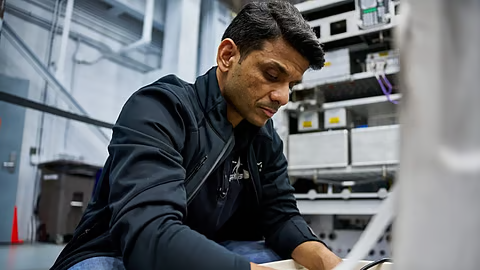
Policy Evolution: A Legal Framework for the Cosmos
The success of Axiom-4 has also accelerated India’s policy and regulatory modernization in space governance.
Key legislative updates expected in 2025–26:
- The Indian Space Activities Bill (revised version):
Grants legal framework for private human missions, orbital tourism, and IP protection for microgravity R&D. - IN-SPACe’s Space Station Use Charter:
Establishes protocols for international astronauts, commercial use, and civilian safety aboard Bharatiya Space Station. - DRDO’s Human Spaceflight Security Code:
Enforces dual-use controls over critical crew systems, especially under international crew scenarios.
India is also a strong contender to join the Artemis Accords, aligning itself with the US-led coalition for sustainable lunar exploration and outer space norms.
India in the 2030s Space Race: Strategic Positioning
India’s global profile in the 2030s space race will be defined by three pillars:
1. Capability Leadership
From robotic explorers to crewed capsules and station modules, India will possess full-stack human spaceflight ability, including orbital launch, recovery, life support, and long-duration mission endurance.
2. Diplomatic Leverage
India will be one of the few nations offering affordable astronaut seats, scientific access to a sovereign space station, and global South access to deep space R&D — enhancing its role in multilateral space governance.
3. Economic Scale
With a projected $40B space economy by 2040, India will likely become the third-largest commercial space market, after the US and China. Its ability to mass-produce space capsules, robots, and microgravity tools will be a global supply chain advantage.
Final Reflections: Voices from Orbit and Earth
As the Axiom-4 mission neared completion, Group Captain Shukla offered a final live message to Earth:
“This is not my mission alone. This is the mission of a billion people who never stopped dreaming. I was only the messenger. The real power lies in our engineers, our scientists, our farmers who looked up at the Moon, and our children who point to the stars. This journey belongs to you. Jai Hind. Jai Bharat.”
He re-entered Earth’s atmosphere on July 9, 2025, with a precision splashdown off the coast of Florida. The Dragon capsule was retrieved by the SpaceX recovery vessel, and within hours, Shukla was speaking with ISRO’s mission control in Bengaluru via secure video link, eyes still adapting to Earth’s gravity, voice unwavering.
Dr. S. Somanath, Chairman of ISRO, called the mission “a torch lighting the path for India’s cosmic century.”
Dr. Peggy Whitson, mission commander, said:
“Shukla was exceptional — calm, curious, and collaborative. India is ready to lead.”
Michael Suffredini, CEO of Axiom Space, added:
“We hope to fly more Indian astronauts. Our commercial space future must include India — as a partner and a pioneer.”
The Legacy of Axiom-4: A New Dawn for India
With Shubhanshu Shukla’s mission, India has not just returned to space — it has redefined its role in the global space order. The 41-year gap between Rakesh Sharma’s 1984 Soyuz flight and the 2025 Axiom-4 journey has been closed with both technical precision and emotional magnitude.
The path ahead is ambitious:
- Launch Gaganyaan by 2026
- Commission the Bharatiya Antariksh Station by 2035
- Send Indian astronauts into lunar orbit by 2030
- Train a new generation of Indian astronauts, engineers, and cosmic storytellers
- Inspire 1.4 billion people to look up and believe
Shukla’s voice from space will now echo in classrooms, labs, and mission control centers — a beacon that reminds India and the world:
“We are orbiting the Earth. This is the start of India’s human space program. Jai Hind, Jai Bharat.”
Also Read : EC to Verify Birth Data of 7 Million Bihar Voters Amid 2024 Vote Theft Allegations


